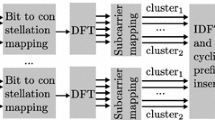Abstract
LTE-Advanced aims to provide a transmission bandwidth of 100 MHz by using carrier aggregation to aggregate LTE Rel. 8 carriers. In order to increase the system capacity, resource allocation becomes a very good tool, and, in the context of the existence of multiple component carriers in LTE-Advanced becomes a complex optimization problem. This paper proposes a Multi-Carrier Scheduling Algorithm that takes into account the user’s QoS requirements and also targets the maximization of the user throughput. The algorithm is evaluated in a scenario with both macro and femto base stations (i.e. a HetNet scenario) that respects the 3GPP specifications. Numerical results show that this algorithm has better performances than the traditional round robin and proportionally fair resource scheduling algorithms.









Similar content being viewed by others
References
Marcu, I., Halunga, S., Fratu, O., & Vizireanu, D. (2011). Multiuser systems implementations in fading environments. InTech. [Online]. http://www.intechopen.com/books/applications-of-matlab-in-science-and-engineering/multiuser-systems-implementations-in-fading-environments
Craciunescu, R., Halunga, S., & Fratu, O. (2012). Guard Interval effects on OFDM /BPSK transmissions over fading channels. In Telecommunications Forum (TELFOR), 20th November 2012 (pp. 471–474).
Dahlman, E., Parkvall, S., & Skold, J. (2011). 4G: LTE/LTE-advanced for mobile broadband. Oxford, UK: Academic Press.
Song, G., & Li, Y. (2005). Utility-based resource allocation and scheduling in OFDM-based wireless broadband networks. IEEE Communications Magazine, 43(12), 127–134.
Girici, T., Zhu, C., Agre, J. R., & Ephremides, A. (2010). Proportional fair scheduling algorithm in OFDMA-based wireless systems with Qos constraints. Journal of Communications and Networks, 12(1), 30–42.
Nguyen, T.-D., & Han, Y. (2006). A proportional fairness algorithm with QoS provision in downlink OFDMA systems. IEEE Communications Letters, 10(11), 760–762.
Parag, P., Bhashyam, S., & Aravind, R. (2005). A subcarrier allocation algorithm for OFDMA using buffer and channel state information. In IEEE 62nd Vehicular Technology Conference Fall VTC-2005-Fall (Vol. 1, pp. 622–625).
Mohanram, C., & Bhashyam, S. (2007). Joint subcarrier and power allocation in channel-aware queue-aware scheduling for multiuser ofdm. IEEE Transactions on Wireless Communications, 6(9), 3208–3213.
Cabral, O., Meucci, F., Mihovska, A., Velez, F., Prasad, N., & Prasad, R. (2011). Integrated common radio resource management with spectrum aggregation over non-contiguous frequency bands. Wireless Personal Communications, 59(3), 499–523. doi:10.1007/s11277-011-0242-6
Siddavaatam, R., Anpalagan, A., Woungang, I., & Misra, S. (2013). Ant colony optimization based sub-channel allocation algorithm for small cell hetnets.Wireless Personal Communications, 1–22. doi: 10.1007/s11277-013-1513-1
Rafea Ahmed, Z., Subramaniam, S., Ahmad Zukarnain, Z., & Othman, M. (2014). Best minimum summation scheduler for long term evolution. Wireless Personal Communications, 1–19. doi: 10.1007/s11277-014-1637-y
Vulpe, A., Fratu, O., Mihovska, A., & Prasad, R. (2013). A multi-carrier scheduling algorithm for LTE-advanced. In 16th International Symposium on Wireless Personal Multimedia Communications (WPMC), 2013 (pp. 1–5).
3GPP. (2010). Evolved Universal Terrestrial Radio Access (E-UTRA): Further advancements for E-UTRA physical layer aspects, 3rd Generation Partnership Project (3GPP), TS 36.814, March 2010. http://www.3gpp.org/ftp/Specs/html-info/36814.htm
I. Cvx Research. (2012). CVX: Matlab software for disciplined convex programming, version 2.0. Retrieved August 2012, from http://cvxr.com/cvx
Grant, M., & Boyd, S. (2008). Graph implementations for nonsmooth convex programs. In V. Blondel, S. Boyd, & H. Kimura (Eds.), Recent advances in learning and control, ser. Lecture Notes in Control and Information Sciences (pp. 95–110). Berlin: Springer. http://stanford.edu/boyd/graph_dcp.html
Boyd, S., & Vandenberghe, L. (2004). Convex optimization. Cambridge: Cambridge University Press.
Acknowledgments
This research activity was supported by UEFISCDI Romania under the Grant No. 20/2012 “SaRaT-IWSN”, by the Ministry of Communications and Information Society of Romania under the Grant No. 106/2011 “Evolution, implementation and transition methods of DVB radiobroadcasting using efficiently the radio frequencies spectrum” and by the Sectoral Operational Programme Human Resources Development 2007–2013 of the Romanian Ministry of Labour, Family and Social Protection through the Financial Agreement POSDRU/107/1.5/S/76903
Author information
Authors and Affiliations
Corresponding author
Appendices
Appendix 1: Proof of Convexity of the Optimization Problem
From the optimization problem in Sect. 3 the following utility function is obtained:
where each weight \(w_{cu}\) is the ratio between the estimated throughput of user \(u\) and the historical average data rate for the same user.
where \(T_u\) represents the potentially achievable data rate and \(R_u\) the historical average data rate.
\(T_u\) is calculated with the help of the following equation:
The historical average data rate is calculated as in the following equation:
It is obvious that \(T_u\) depends only on the SINR experienced by the user \(u\) attached to cell \(c\). At the moment (the current TTI) the scheduler makes its decision, all the received powers, as well as the channel gains are constants. We can therefor say that \(C_1 = \sum _n \log _2 \left( 1+{A_t}_{c,u}^n \cdot \frac{P_{TX,c,u}^n \cdot |h_{c,u}^n|^2}{\sigma ^2 + \sum _{j\ne c}^C P_j^n \cdot |h_{j,u}^n|^2}\right) = const.\) Likewise, the historical average data rate is also a constant, since it depends on the average data rate, and the experienced throughput in the last TTI. Consequently, \(C_2 = R_u = const.\)
By rewriting Eq. 17, we obtain:
Where \(f^{cu}\) is an affine function:
Since an affine function is also a convex function and since the sum of convex functions preserves the convexity of the function [16], we obtain that \(-u(x_{11},x_{12},...,x_{1N_c},x_{21},...,x_{N_cN_c})\) is a convex function.
Appendix 2: Proof of the Upper Bound for Number of Users of the Cell
Considering Eq. 12 and knowing that
we obtain
From Eq. 10, considering also that the component carriers have equal bandwidths (\(N_{PRB_c} = N_{PRB} \forall c \in \{1,...,N_c\}\)), we obtain:
Rights and permissions
About this article
Cite this article
Vulpe, A., Mihovska, A., Fratu, O. et al. Admission Control and Scheduling Algorithm for Multi-carrier Systems. Wireless Pers Commun 93, 629–645 (2017). https://doi.org/10.1007/s11277-014-2218-9
Published:
Issue Date:
DOI: https://doi.org/10.1007/s11277-014-2218-9




